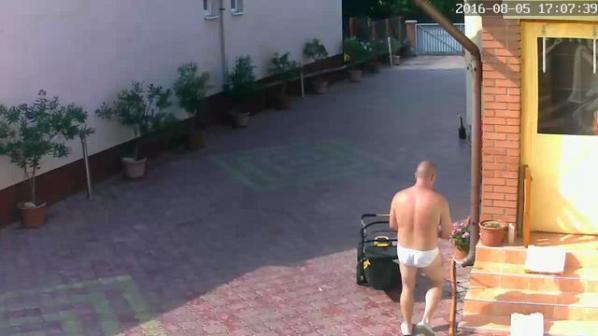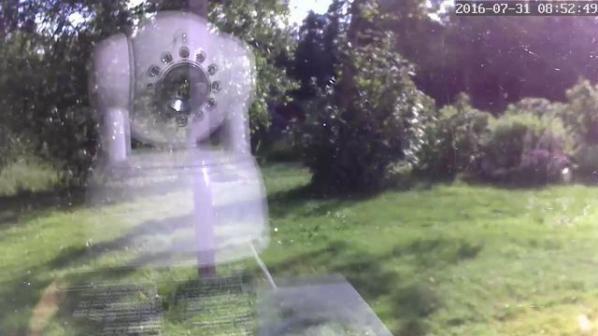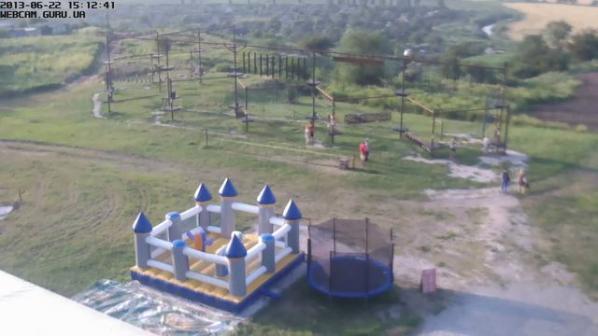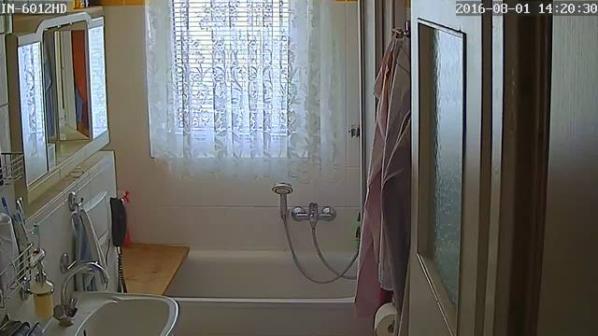



Featured image: 98.235.73.27, 2016-07-10
Nye Thompson is a London-based artist whose work explores the interface between physical and virtual domains. Her recent artwork Backdoored involves the collection and online archiving of images taken via unsecured surveillance cameras worldwide. Backdoored was featured at Internet Yami-Ichi at Tate Modern in May this year. Backdoored.io, curated by Kosha Hussain, followed as a solo show at Bank Gallery, London in August. Artist Millicent Hawk interviews Nye on the technology, aesthetics and universal conditions that make this work both compelling and uneasy at once.
Millicent Hawk: Backdoored is transparent in its approach – the website tagline reads, ‘Intrusion | Surveillance | Exposure’. And whilst there have been a few (mostly misinformed) concerns aired publicly about the invasive nature to the work since the first solo exhibition of it this year, you’re not actually a hacker and these images existed already before – can you explain how these images are taken and the issues they raise.
Nye Thompson: To me, Backdoored highlights the technological erosion of our privacy and through this work I’m exploring the factors that make us active contributors to this process. A ‘backdoor’ is slang for a feature or defect in a device that allows the bypassing of normal authentication. These images are generated by softbots belonging to specialist search engines which trawl connected devices (the Internet of Things) for security testing. The bots take pictures when they discover an unsecured camera and save them into their search results. In most cases the owner of the camera has no idea this is happening.
For some time now I’ve been interested in the Internet of Things and its potential impact on our personal privacy and liberties, but how do you create artistic discourse around something so abstractly technical? So when I first discovered these images they were revelatory for me because they provided me with a ready-made visual language to talk about these issues. There is also a performative thread running through the project: every day I get sent new images, and I attempt to unpick meaning from their apparent randomness by developing taxonomies and applying them to each one.
MH: So how does one avoid being, ahem, Backdoored ?
NT: If you have an IP surveillance camera in your home then you are basically broadcasting your domestic life onto the internet. This data needs to be protected by setting a unique, secure passcode on the camera. The images in Backdoored come from cameras that don’t have this. Part of the problem is a toxic combination of low public awareness of privacy risks combined with profit-hungry manufacturers and lack of regulation. But these Backdoored cameras are just harbingers of what is to come – a future surrounded by smart objects all collecting and sharing data about us.

MH: The word ‘Backdoored ’ implies something that’s both disturbing but potentially exciting too, although, with explicit reference to the screenshots of a child or an elderly person in bed, combined with geo-location details – it’s totally creepy. However, those particular images aside, there’s something fascinating with many of the vidcam shots. Bots are set off to capture the image at a single point of finding unsecured domains so people are captured in their domestic settings – at ease in their pants, for example. This serendipitous and incidental timing without a human-decisive moment or any playing to the camera makes these images – albeit voyeuristic – seemingly more representative of the real and something nearer to the truth. So the digital aspect to the dark world of unsecured vidcams brings me intrigue as well as valid concerns over individual rights to privacy.
NT: Yes, although images of people in their homes form only a part of the surveillance images I find; there are wastelands, machinery, bars, building sites, hidden cameras, zombie cameras – forgotten but still broadcasting. They form a kind of covert mapping of contemporary concerns and anxieties worldwide.

MH: Yes, this is different to public surveillance and government snooping which – for the most part – seems to have been accepted. Similarly to public surveillance though, home vidcams seem an unnecessary reaction to an underlying and excessive state of fear, and the voracity to control; anxieties in these images then are represented through the choice of self-prescribed surveillance.
NT: Yes, it seems like the scenes and objects in these pictures predominantly represent a kind of metaphysical anxiety, or a way to reassure ourselves of object permanence. These are things that we feel we need to monitor constantly in case something bad happens, although it’s not always clear how we would meaningfully intervene. It’s a classic case of a technology creating a need, and a new demand on our attention. Suddenly we have the ability to watch the people and things in our life 24/7, and so not watching can almost feel like a failure to care. Yet at the same time there is a distancing, as we engage with our babies, our elderly parents, our pets, our work colleagues, our possessions – as live video streams rather than through physical, embodied interaction.

MH: Thinking back to earlier this year, Backdoored was a new idea for you. And something that I – and presumably many people – weren’t even aware was happening. At the time, we discussed the premise for this work and shared our concerns of how ethics get outpaced by rapid technological development. How do you reconcile Backdoored seeing that these images bring greater intrusion to those whose privacy they reveal?
NT: This is an important question. These images are already out there for anyone to find, and more significantly millions of these cameras are insecure and vulnerable, yet, as you said, many people are not aware of these facts. Of course I am conscious that by bringing people’s attention to them I am also amplifying the images, so there are ethical and curatorial challenges here. But these images do already exist and I’m using them in a very direct way – drawing attention to privacy and surveillance issues. There’s immediacy to imagery that resonates when a full-length article might not. I think public reports on privacy issues, by organisations like Privacy International & Big Brother Watch (to name just two), are massively important but they are endlessly firefighting this international problem. Who’s to say art can’t have an effect on these issues too?
MH: Raising awareness helps – last week I made a studio visit to an artist who had a Backdoored postcard on his desk, the tape over his webcam was a recent addition since seeing your work at Tate Modern. But, further to public awareness, lawmakers, regulators, manufacturers and commercial watchdogs need to work together to ensure privacy matters. That said, state surveillance is at a insanely invasive level – I’m thinking of GCHQ’s Smurf Suite and the Investigatory Powers Bill (which targets journalists’ privacy on whistleblowers) – vidcam backdoors perhaps seem trivial for a government to attempt to regulate and, perhaps, are even a welcomed accessory to state surveillance. On the issue of state surveillance, you were faced with some rather heavy legal threats – explain.
NT: Ah yes. Backdoored.io at Bank Gallery this year triggered an official complaint from the Hong Kong Commissioner. One of the works featured domestic scenes from Hong Kong – they seem to use a disproportionately high volume of unsecured surveillance cameras in their homes. First I received legal threats from a Chinese newspaper, then Channel 4 news weighed in with a recorded complaint from the Commissioner and demanded that I give them a (pre-recorded) interview in response. They then broadcast a sensationalised news piece, using a heavily cut version of my interview. The news article attacked me for my use of these images, while at the same time deliberately obfuscating the privacy and technology issues and how the images came to exist in the first place. Ironically, a few weeks later, the media was full of reports that the FBI was advising people to put tape over their webcams to protect their privacy!

MH: Ha, fifteen years too late. In terms of the complaint from the Chinese Commissioner for Hong Kong, it seems rather duplicitous that a country with the most pervasive internet censorship to maintain control over it’s public (I understand ProtonMail has a large Chinese user base) would be interested in threatening a UK artist here – what’s the percentage of webcams that are manufactured in China?
NT: No comment 😉
MH: So what’s next for Backdoored and how do you see the future for privacy?
NT: Backdoored highlights this very real and disturbing fact – these images already exist. What does this imply for us now and what does it imply for the future? Backdoored foregrounds privacy and surveillance, although, as an artist, I’m also interested in these images as material: the social and cultural messages encoded within them; their robotic origin; and the complex responses they evoke in the viewer. These images are signifiers for some of the epic power struggles* currently taking place at the cutting edge of technological development. This surrendering of our privacy seems like a one-way ticket; once we’ve lost that could we ever get it back? What we want for our futures must be dealt with now.
* In recent weeks we have seen just how easily these unsecured cameras can be ‘weaponised’ by hackers. For example, millions of these cameras have now been infected with the Mirai and other viruses. This allows them to be conscripted into giant ‘botnet’ armies which can be used to attack or censor other parts of the Internet.
Nye Thompson’s Backdoored will be in TERMINAL, a group exhibition opening at Avalanche in December. For 2017 she is planning a UK touring show, and also a panel discussion on issues raised by the project. Event details can be found on the Backdoored website.
Contact:
@nyethompson
www.Backdoored.io